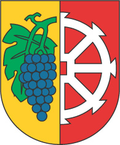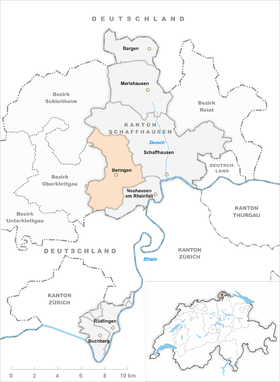Beringen SH
| SH is the abbreviation for the canton of Schaffhausen in Switzerland and is used to avoid confusion with other entries of the name Beringen . |
| Ringing | |
|---|---|
| State : |
|
| Canton : |
|
| District : | Schaffhausen |
| BFS no. : | 2932 |
| Postal code : | 8222 Beringen 8223 Guntmadingen |
| UN / LOCODE : | CH BER |
| Coordinates : | 685 105 / 283694 |
| Height : | 449 m above sea level M. |
| Height range : | 406–809 m above sea level M. |
| Area : | 18.68 km² |
| Residents: | 4804 (December 31, 2018) |
| Population density : | 257 inhabitants per km² |
|
Proportion of foreigners : (residents without citizenship ) |
18.8% (December 31, 2,013) |
| Website: | www.beringen.ch |
|
View of Beringen from the Beringen Randenturm |
|
| Location of the municipality | |
Beringen is a municipality in the canton of Schaffhausen in Switzerland . On January 1, 2013, Guntmadingen merged with Beringen.
geography
Beringen is located in the agricultural Klettgau , at the foot of the Randen . It borders in the northeast on Schaffhausen , in the southeast on Neuhausen am Rheinfall , in the south on Jestetten ( Baden-Württemberg , Germany ) and in the west on Siblingen , Löhningen and Neunkirch . The geographical center of the canton of Schaffhausen is in the Eschheimertal , near the Beringer Randenturm .
history
Beringen is one of the places in today's canton of Schaffhausen that is mentioned for the first time early on, namely in 1090 in a deed of donation from Count Burkhard von Nellenburg to the Allerheiligen monastery in Schaffhausen.
The certificate of Emperor Otto I from the year 965, which is often cited as the first mention of Beringen, is a forgery from the second half of the 12th century.
But people lived in Beringen as early as the Bronze Age , around 3,500 years ago, and rich graves were found. Around 2,000 years ago it was the Romans who founded a settlement - an estate - in the Lieblosental . They were later pushed back over the Alps by the Alemanni .
In the early Middle Ages , Beringen was actually founded as the Bero settlement . A small burial ground in the Spinnbündten corridor bears witness to this settlement, which has produced extremely valuable finds, fibulae (brooches) made of silver and gold, as well as bronze and glass vessels. They are among the most valuable finds of this time on Swiss soil and prove that a wealthy family lived here in the 7th century.
There is evidence of a noble family in Beringen from the High Middle Ages : The Hünen von Beringen . They owned the castle in the center of the village , which is hardly recognizable today .
No reliable information can be given about the previous population figures. After all, in a list of the hearths for Beringen 43 is given in 1530 (for comparison: Neunkirch 92, Gächlingen 24, Neuhausen 12, Trasadingen 10, Guntmadingen 5). These figures show that Beringen was larger than the neighboring Neuhausen at that time and was one of the most important village communities in what was then the city-state of Schaffhausen.
In 1840, Eduard Im Thurn , the first statistician from Schaffhausen , described Beringen with the following words: "Parish village with 145 fire places, is located on the road from Schaffhausen to Freiburg im Breisgau . Its residents cultivate fruit, vines, meadows and arable land, many of whom are paid daily same in town. "
Thanks to advances in medicine and hygiene, the population had increased rapidly from the end of the 18th to the middle of the 19th century. This strong increase in population led to a fragmentation of goods in agriculture with many small and hungry businesses. The community could soon no longer feed its residents, so that by 1852 149 ringers had to emigrate to America.
Beringen was still a small farming village until the beginning of the 20th century. The village coat of arms also reminds of this. Wine and bread were the most important foodstuffs for the inhabitants and their production was their most important part of life.
With the industrialization of the city of Schaffhausen and the neighboring town of Neuhausen, Beringen turned into a suburb of this new industrial agglomeration during the 1930s and 1940s. Since the 1960s, Beringen quickly became an industrial community itself.
coat of arms
- Split from yellow with blue grape and from red with white half mill wheel.
Beringen's patron saint is St. George . He can also be seen as a mounted dragon slayer on a white background on a pictorial representation of the coat of arms from the 16th century. Later, a black, growing bear in yellow can be seen on the coat of arms on the coat of arms. Since the name of the village is derived from Bero (bear), this coat of arms was a symbol of the name. At the time of the Ancien Régime a new coat of arms was developed, which on the one hand took into account the mills that had existed for centuries, and on the other the viticulture that was flourishing at the time . The oldest seal with this coat of arms is from 1804. A seal of justice of the peace is still preserved from 1839 , which bears a Swiss cross instead of the vine.
When the municipal coat of arms was chosen in 1949, the coat of arms with St. George was dispensed with, as one wanted to avoid confusion with the coat of arms of Stein am Rhein , and it was not considered appropriate for a Protestant community to have a saint in its coat of arms. The proposal to include the bear in the coat of arms was ultimately rejected in favor of the previously used coat of arms.
politics
The legislature of Beringen is formed by the residents' council. It has 13 members and is elected proportionally every four years . The graphic opposite shows its composition since the election on November 27, 2016.
The municipal council forms the executive branch of the municipality. It consists of five members who are elected by the majority every four years . It is headed by the mayor, currently Hansruedi Schuler (FDP, as of 2016).
traffic
On the eastern edge of Beringen, Hauptstrasse 14 ( Frauenfeld - Schaffhausen - Neuhausen am Rheinfall - Schleitheim - Freiburg im Breisgau ) and Hauptstrasse 13 (also Europastrasse 54 , Singen am Hohentwiel - Schaffhausen - Neuhausen am Rheinfall - Trasadingen - Waldshut - Basel ) are divided. .
A not completely asphalted side street leads from Beringen over a small ridge to the Breite quarter of the city of Schaffhausen . This road is also called the “Kistenpass” because it leads over a high point on the Randen .
The Hochrheinbahn (Schaffhausen – Erzingen – Waldshut – Basel) runs through Beringen, where there is the Beringen train station and (since autumn 2013) a Beringerfeld stop , which are served by local trains. There are also two intercity bus routes: one from Schaffhausen to Schleitheim (regional line 21), the second from Schaffhausen to Erzingen (German Südbadenbus GmbH ). On October 5, 2013, the expansion of the railway line between Erzingen and Schaffhausen station was completed and put into operation. It was expanded to two tracks from Erzingen to Beringen to a length of 12.5 km and electrified to Schaffhausen. Since then, the Schaffhausen S-Bahn has been running to Trasadingen and Erzingen every half or hour.
Culture and sights
The local museum in the heart of Beringen is a residential tower from the 13th century. The so-called “castle” was the ancestral seat of the “Noble Hün von Beringen” who owned the village bailiwick in the High Middle Ages . It contains a folk collection of machines from handicrafts, fire departments and the military, as well as works by regional artists.
The Beringer Randenturm outside the village is a popular vantage point for locals and visitors. The 26 meter high steel structure was built in 1998, replacing the wooden tower that had been on the site until then.
Beringen has an active club life with over 50 clubs from various areas.
education
Beringen has schools for all ages and levels. Since the surrounding communities of Löhningen and Guntmadingen do not run any secondary or junior high schools, the young people go to school in Beringen.
There used to be various primary schools in Beringen. The "old schoolhouse" on Schulberg, which was no longer used as a school for a few years after the new Schützeweg schoolhouse was built, now houses a toy library operated by Pro Juventute .
The "pavilion" on Zimmerberg was a temporary solution with 3 buildings, which was demolished in 2004. The Haargasse double kindergarten is located at its location today. In 1995 the Schützeweg I and II school buildings, which were mainly used by the primary school, were completed.
The older Zimmerberg I secondary and secondary school building is located south of the Schützeweg primary school buildings. The facility has a sports hall (“old gym”), in a building opposite are the multi-purpose hall (“Zimmerberghalle”) used for events and the “new gym”. In February 2014, the Zimmerberg II upper school building to the west of the older upper school building was inaugurated; it was built by the Zurich architects Niedermann Sigg Schwendener and within two years.
A double kindergarten has been located on Gellerstrasse for a long time, while the Haargasse kindergarten in the south of the Zimmerberg school area was expanded into a double kindergarten in August 2015. Some of the kindergarten teachers in the Beringen / Gundmadingen community attend the kindergarten in the Guntmadingen schoolhouse.
freetime and sports
The Gwaagge Badi outdoor pool was opened in 1969, and since the renovation in 2013/14 it has had natural water treatment by means of a pond.
Compared to the size of the village, Beringen has a very good range of sports. A fitness center, several soccer fields, a basketball court, a skateboard halfpipe and a total of 8 tennis courts on 4 facilities give athletes the opportunity to be active in a variety of ways.
literature
- Kurt Bächtold: Beringen , in: Schaffhauser Magazin, 11, 1988, No. 2, pp. 15-91.
- Kurt Bänteli: The building history of Beringen Castle , in: Schaffhauser contributions to history, 65, 1988, pp. 31–49.
- Walter Ulrich Guyan: Beringen. The village and its landscape , Beringen 1983, ISBN 3-8580-5122-5 .
- Armin Rahm, Rita Rahm: Local history guide through Beringen , Beringen 2000.
- Ewald Rahm: Beringen. Our village once (in pictures) and now (in the text) , Beringen 1993.
- Mathias Schmidheiny: The early medieval burial ground of Beringen-Spinnbündten , Schaffhausen 2006, ISBN 3-9521-8685-6 .
- Markus Schwyn-Hager: Beringen , in: Schaffhauser Magazin, 28, 2005, No. 1, pp. 9-49.
Web links
- Official website of the municipality of Beringen
- Robert Pfaff: Beringen. In: Historical Lexicon of Switzerland .
Individual evidence
- ↑ Permanent and non-permanent resident population by year, canton, district, municipality, population type and gender (permanent resident population). In: bfs. admin.ch . Federal Statistical Office (FSO), August 31, 2019, accessed on December 22, 2019 .
- ↑ Permanent and non-permanent resident population according to institutional structure, gender, nationality and age. Municipality of Beringen. Status: April 1, 2012, accessed on July 11, 2014
- ^ Presentation of the local history on the website of the municipality of Beringen, accessed on December 7, 2012
- ^ Bruckner-Herbstreit, Berty: The emblems of the state of Schaffhausen and its communities , Reinach-Basel 1951, pp. 177–180.
- ^ Minutes of the election of the residents' council. (PDF) Beringen municipality, November 27, 2016, accessed on November 28, 2016 .
- ↑ http://www.pro-juventute.ch/Ludothek-Beringen.4279.0.html







